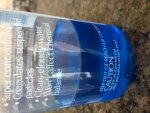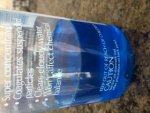Those chunks look like what I got in my pump basket after my plaster pool had been chipped out prior to my Pebble Sheen re-plaster. After about a week or so after the replaster I started to get them. I didn't have any borax in the pool. I figure it must have been plaster dust/bits clumping together. I did also have a sock of CYA in the skimmer the week after the pool had been filled prior to the chunks showing up??
Borax Hardening In Salt Pool
- Thread starter bxcrwlly
- Start date
You are using an out of date browser. It may not display this or other websites correctly.
You should upgrade or use an alternative browser.
You should upgrade or use an alternative browser.
gtemkin: My CYA is granular; however, I also add that via the skimmer in a sock. The reason I use the skimmer/sock method for both Borax/CYA resulted in a suggestion from previous postings where I was questioning the origin of these "chunks." A forum member suggested using the skimmer vs. spreading via pool floor and then brushing toward the main drain. If I recall, it was believed that maybe the origin of the chunks were a result of accumulation somewhere from the main drain to the pump pot. Obviously, this problem has not resolved.
wjr75: No plaster work. Pool finished and operational in April 2011. Late in fall of 2013, we had staining issues around the wall. The pool company classified them as hydration stations. They provided me the name of a sub-contractor who came in and did two acid baths on the pool and spa. After those were completed and my pool was balanced and operational again, the stains slowly dissipated. It took approximately 3 months for them to completely disappear. I suspect the acid baths "could have" created a similar situation to what you noted in your post; however, I'm merely speculating at this point.
- - - Updated - - -
JohnT: I'll obtain some distilled water and perform the tests mentioned in your post and provide my results.
- - - Updated - - -
JohnT: I'll obtain some distilled water and perform the tests mentioned in your post and provide my results.
JohnT, et. all: I ran a PH, CH, Borate and CYA test with one of the chunks using 24 oz. distilled water. Here are the results:
PH was purple - Off the scale re. my test kit
CH - Initially, the sample changed from red to blue at 70. I was using my SpeedStir and shortly the sample changed back to red again. This scenario repeated until I stopped at 16 drops(160ppm) when I turned the Speedstir off. The sample remained blue.
Borate = 0(Zero)
CYA = 30ppm
So what conclusion do we draw at this point? The chunks that were removed the longest are extremely light and somewhat powdery to the touch. They break apart very easy.
PH was purple - Off the scale re. my test kit
CH - Initially, the sample changed from red to blue at 70. I was using my SpeedStir and shortly the sample changed back to red again. This scenario repeated until I stopped at 16 drops(160ppm) when I turned the Speedstir off. The sample remained blue.
Borate = 0(Zero)
CYA = 30ppm
So what conclusion do we draw at this point? The chunks that were removed the longest are extremely light and somewhat powdery to the touch. They break apart very easy.
My guess would be that the white chunks are a calcium compound. Maybe the CYA test result is being skewed by cloudiness in the water from the calcium.
Do you have a phosphate test? It could be calcium phosphate if both were very high. Otherwise it's more likely to be calcium carbonate, but that should fizz more than it did when you added acid to it.
Did you do a TA test? It should have come up with roughly the same number as the CH test.
If you were to dissolve 70 ppm calcium carbonate in distilled water, the pH would get to 10.3, the TA and CH each to 70 ppm.
If this were calcium phosphate, as shown in this link, you'd start to precipitate calcium phosphate with the following combinations with CH and pH in ranges you've reported.
pH . CH . Phosphate
7.5 . 250 . 33,715 ppb
8.0 . 250 . 15,952 ppb
7.5 . 450 . 18,730 ppb
8.0 . 450 . 8,862 ppb
Those would be extraordinarily high phosphate levels only seen when one uses large amounts of a phosphate-based metal sequestrant.
Did you do a TA test? It should have come up with roughly the same number as the CH test.
If you were to dissolve 70 ppm calcium carbonate in distilled water, the pH would get to 10.3, the TA and CH each to 70 ppm.
If this were calcium phosphate, as shown in this link, you'd start to precipitate calcium phosphate with the following combinations with CH and pH in ranges you've reported.
pH . CH . Phosphate
7.5 . 250 . 33,715 ppb
8.0 . 250 . 15,952 ppb
7.5 . 450 . 18,730 ppb
8.0 . 450 . 8,862 ppb
Those would be extraordinarily high phosphate levels only seen when one uses large amounts of a phosphate-based metal sequestrant.
chem geek: I do have a phosphate test. I ran two tests. 1) Pool water tested 0 phosphates. 2) Distilled water with crushed chunk also tested 0 phosphates. I ran another acid test on a couple of "chunks" and captured the results via video; however, I'm not permitted to upload videos to the site, so I took a still shot as the acid was added. Trying to demonstrate "fizz" action. The chunks turned yellow when contacted with acid. Please comment...thanks.
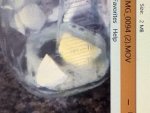

The fizzing is likely the calcium carbonate having the carbonate combine with acid to form carbon dioxide. So these chunks are not borax but are at least in part calcium carbonate precipitation/scaling. Why they are forming as chunks I do not know. There may be somewhere in the system that is at high pH where these form and grow.
I'm not sure about what is causing the yellow color.
I'm not sure about what is causing the yellow color.
sbcpool
Well-known member
If you have the equipment, perhaps it would be illuminating to get the weight of some dry chunks and then use something like a graduated cylinder to measure their volume. A density measurement could give further clues about their nature.
et. all: This is a wild guess on my part. I've been using a clarifier in my pool. Per the dosage, I add 2 ounces weekly mixed with 5 gallons of pool water and dispense around the pool, when I brush/vacuum. My wife says it makes the water really sparkle...hmmmmm. Anyway, wondering since the clarifier is a coagulant, if it is causing some bonding reaction producing these "chunks." I've including some pics identifying the description on the product bottle. Interestingly enough, I haven't added any in the last 3 weeks and no chunks have appeared in my pump pot after using the spa on several occasions. Appreciate any feedback.
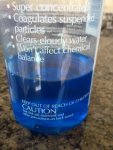
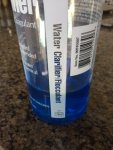


Attachments
Well yes, a clarifier would consolidate particles so if you had over-saturation of calcium carbonate then it could precipitate it and create chunks of it. There should be no need for you to use a clarifier if you use the proper levels of chlorine to CYA (FC/CYA ratio), run your pump the appropriate amount of time, and have a decent filter. Look at my pool where I don't use any clarifier:
https://www.troublefreepool.com/~richardfalk/pool/PoolDay.jpg
https://www.troublefreepool.com/~richardfalk/pool/PoolNight.jpg
https://www.troublefreepool.com/~richardfalk/pool/PoolDay.jpg
https://www.troublefreepool.com/~richardfalk/pool/PoolNight.jpg
chem geek: Well now, maybe the mystery is solved. I will continue to refrain from using the clarifier. I do use the recommended levels and pump operation in accordance with TFP standards. Filter is cleaned every other week during swim season.
Beautiful pool you have there!
Beautiful pool you have there!
Thread Status
Hello , This thread has been inactive for over 60 days. New postings here are unlikely to be seen or responded to by other members. For better visibility, consider Starting A New Thread.


